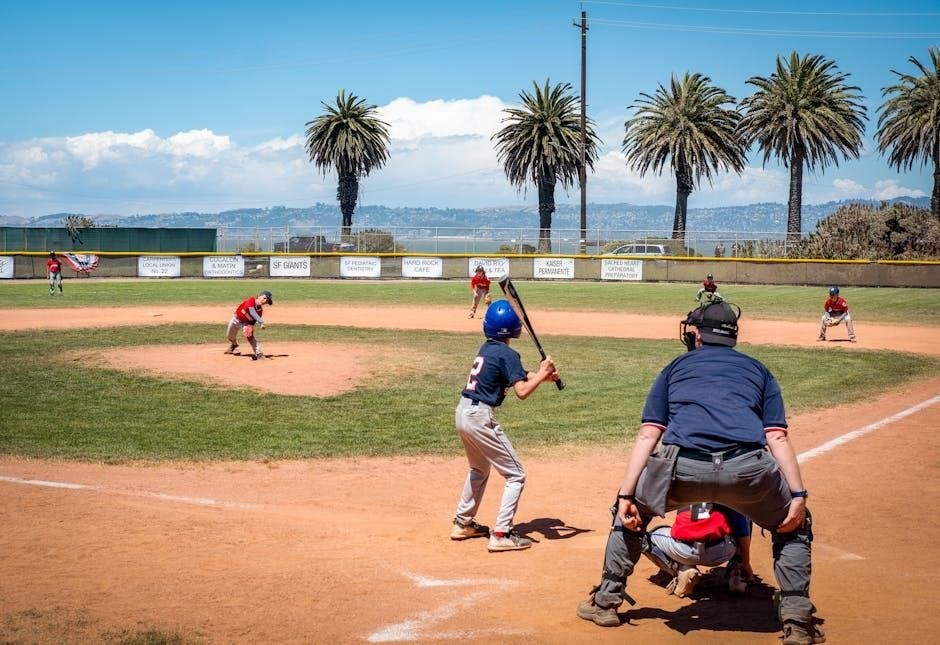Baseball third base coach signals are essential for strategic communication, guiding runners and batters through hand gestures, verbal cues, and decoys to execute plays effectively and outsmart opponents.
Overview of the Role of the Third Base Coach
The third base coach plays a pivotal role in baseball, serving as the final link between the dugout and players on the field. They are responsible for relaying offensive strategies through a variety of signals, including hand gestures, verbal cues, and decoys. The coach must possess excellent game-reading abilities, making split-second decisions to guide runners and batters effectively. Their primary duties include directing baserunners, signaling steals, and coordinating plays like bunts and hit-and-runs. Strong communication and timing are critical, as the coach’s decisions directly impact the team’s ability to score and minimize risks during critical game moments.
Importance of Signals in Baseball Communication
Signals are the lifeblood of baseball communication, enabling quick and precise coordination between coaches and players. The third base coach relies on hand gestures, verbal cues, and decoys to convey strategic instructions, ensuring players execute plays effectively. Clear communication is critical, as misinterpretation can lead to missed opportunities or costly errors. Signals must be timely, concise, and easily understandable to prevent opponents from decoding them. Effective signaling fosters teamwork, adaptability, and tactical execution, making it a cornerstone of successful baseball strategy. Consistency and clarity in signaling are essential for building trust and ensuring players respond appropriately in high-pressure situations.
Evolution of Third Base Coach Signals in Modern Baseball
Third base coach signals have evolved significantly, adapting to modern baseball’s strategic demands. Historically, signals were simple, relying on basic hand gestures. Today, they incorporate advanced techniques, including decoys, verbal cues, and body touch signals, to outsmart opponents. The integration of technology, such as wearable devices and apps, has enhanced signal systems, allowing for faster and more discreet communication. Coaches now use claps, hat touches, and other creative methods to convey instructions. This evolution ensures signals remain effective while keeping opponents guessing. Modern strategies emphasize adaptability, enabling teams to adjust signals based on game situations and player capabilities, ensuring a competitive edge.
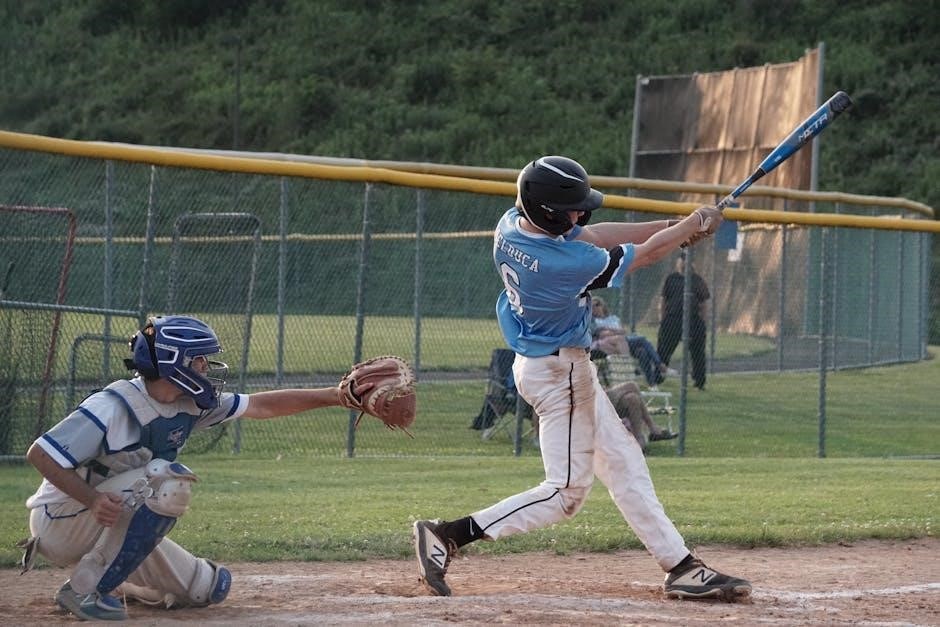
Types of Signals Used by the Third Base Coach
Third base coaches use hand signals, body touch cues, verbal commands, and decoys to guide runners and batters, ensuring strategic execution while confusing opponents.
Hand Signals: Common Gestures and Their Meanings
Hand signals are a cornerstone of baseball communication, with the third base coach using specific gestures to convey strategies. Common signals include touching the hat brim, belt, or chin, each indicating actions like stealing bases or bunting. Coaches often develop unique systems, ensuring clarity and consistency. For example, a hand swipe across the chest may signal a bunt, while a tap on the helmet could indicate a steal. These gestures must be precise to avoid confusion, as misinterpretation can lead to missed opportunities. Players rely on these visual cues to execute plays effectively, making hand signals a vital tool in the coach’s arsenal for in-game decision-making.

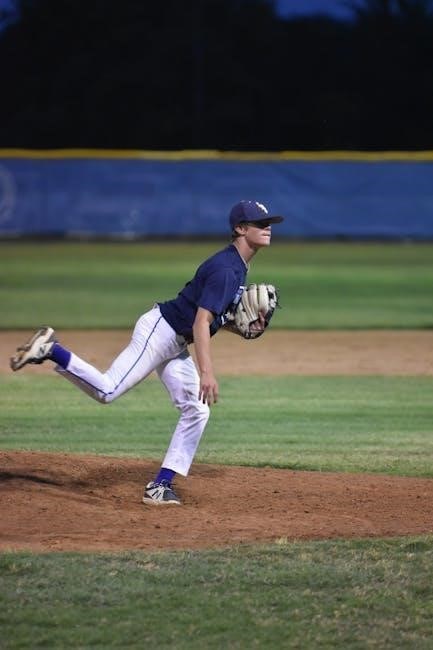
Body Touch Signals: Using Body Parts to Communicate
Body touch signals are a crucial part of a third base coach’s communication arsenal. By touching specific body parts like the elbow, nose, belt, or hat, the coach can signal plays such as steals or bunts. Each touch corresponds to a particular action, ensuring quick and precise communication. Consistency is key to avoid confusion among players. These signals are part of a broader strategy, allowing the team to execute plays seamlessly. Effective use of body touch signals enhances teamwork and can lead to successful outcomes on the field, making them an indispensable tool in the coach’s playbook.
Verbal Cues: Enhancing Communication with Words
Verbal cues are a dynamic component of baseball communication, used by third base coaches to reinforce or clarify signals. Coaches often use specific phrases or claps to indicate plays, such as steals or bunts, ensuring quick execution. These cues are particularly effective in high-pressure situations, where clarity is crucial. Verbal signals can also serve as decoys, misleading opponents about the intended play. Consistency in verbal communication is vital to avoid confusion among players. By combining verbal cues with hand or body signals, coaches create a layered system that enhances teamwork and strategic execution, giving the team a competitive edge on the field.
Decoy Signals: Misleading the Opponent
Decoy signals are strategic tools used by third base coaches to mislead opponents, preventing them from anticipating plays. Coaches employ false hand gestures, body touches, or verbal cues to disguise their intentions. For example, touching the elbow or hat brim might signal a steal, while a decoy gesture could imply a bunt. These signals are designed to confuse the opposing team, creating uncertainty and delaying their reactions. Effective decoy signals require precise timing and coordination with players. By blending genuine and fake signals, coaches maintain an edge, ensuring opponents cannot easily decode their strategies. This art of deception is vital in high-stakes baseball scenarios.

Offensive Strategies and Signals
Offensive strategies involve stealing bases, bunting, and hit-and-run plays, with signals from the third base coach guiding runners and batters to execute plays effectively and maximize scoring opportunities.

Stealing Bases: When and How to Signal
Stealing bases is a critical offensive strategy, with the third base coach using specific signals to indicate when a runner should attempt to advance. These signals often involve hand gestures or body touches, such as touching the elbow or nose, to communicate the plan. The coach must carefully read the game situation, including the pitcher’s move and the catcher’s throw, to determine the optimal moment to signal a steal. Timing and execution are crucial, as the runner must react quickly to the signal while avoiding detection by the opposing team. Effective signaling ensures the runner has the best chance of successfully advancing, contributing to the team’s scoring opportunities.
Bunting: Signals for Sacrifice and Drag Bunts
Bunting is a strategic play where the batter intentionally hits the ball softly, often to advance runners. The third base coach signals for sacrifice or drag bunts using specific gestures, such as touching the belt or chin, to indicate the type of bunt. Sacrifice bunts aim to move runners into scoring position, while drag bunts are designed to reach base safely. The coach must read the game situation, including the score and inning, to determine when to signal a bunt. Clear and timely signals ensure the batter executes the play effectively, maximizing the team’s offensive potential and creating scoring opportunities.
Hit-and-Run Plays: Coordinating Runner and Batter
Hit-and-run plays require precise coordination between the runner and batter, directed by the third base coach. The coach signals the play using specific gestures, such as a hand clap or touch to the hat brim, indicating the runner should advance as the pitcher begins their motion. The batter times their swing to make contact, often aiming for a ground ball to prevent a double play. This strategy creates potential base hits and pressures the defense. The coach’s signals must be clear and timely to ensure synchronization, making the hit-and-run a powerful offensive tactic for advancing runners and scoring runs effectively in game situations.
First-and-Third Situations: Maximizing Scoring Opportunities
In first-and-third situations, the third base coach plays a crucial role in maximizing scoring opportunities. The coach uses hand signals or verbal cues to instruct the runner on third base, such as signaling a steal, a squeeze bunt, or a hit-and-run play. The batter is also cued to execute a specific type of hit or bunt to advance the runner. The coach must read the defense’s alignment and pitcher’s moves to decide the best strategy. Clear and timely signals ensure the runner and batter are synchronized, increasing the chances of scoring. This high-pressure situation demands precise communication to capitalize on scoring potential effectively.

Defensive Strategies and Signals
Defensive strategies involve the third base coach reading opponents’ plays, coordinating with pitchers and catchers, and aligning fielders to anticipate bunts, steals, and other offensive moves effectively.
Reading the Opponent: Anticipating Plays
Reading the opponent is crucial for defensive success. The third base coach studies the opposing team’s tendencies, such as batter swing patterns and base runner aggressiveness, to anticipate potential plays. By observing these cues, the coach can signal fielders to position themselves strategically, increasing the likelihood of making outs. For example, if a batter frequently pulls the ball, the coach may align the infielders to the right. Similarly, if a runner is known for stealing, the coach might signal the catcher to throw to second base. This proactive approach helps the defense stay one step ahead, minimizing scoring opportunities for the opposition.
Pitcher and Catcher Signals: Coordination and Timing
Pitcher and catcher signals are vital for defensive coordination, ensuring timely execution of pitches and plays. The third base coach often integrates with this system, signaling the pitcher and catcher to execute specific sequences or pitchouts. For example, a catcher may flash a sequence of signs to the pitcher, indicating the type of pitch and location. The coach may add a secondary signal to initiate a pickoff play. Timing is critical, as any delay can tip off the opponent. This synchronized communication prevents runners from anticipating plays, maintaining defensive effectiveness and control over the game’s flow.
Bunt Defense: Aligning Fielders Effectively
The third base coach plays a key role in bunt defense by signaling infielders to position themselves appropriately. Hand signals, such as touching the belt or brushing the hat brim, indicate the type of bunt expected. This allows infielders to creep in or shift, ensuring proper alignment; The coach may also signal the pitcher to throw high and inside to disrupt the batter’s timing. Effective bunt defense requires precise coordination between the coach, pitcher, and fielders. By anticipating the bunt and aligning the defense, the team can minimize the opponent’s scoring opportunities and maintain control of the game’s momentum.
Situational Strategies
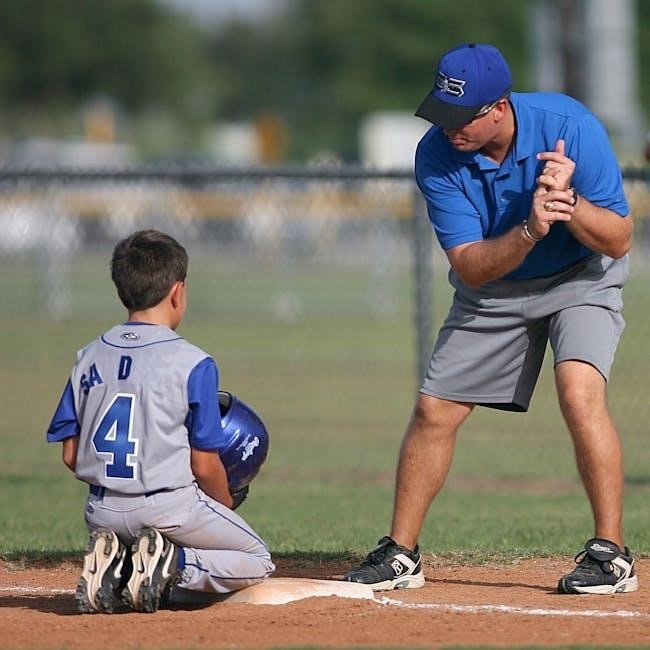
Situational strategies involve adapting signals for high-pressure moments, such as late-game situations, runners on second, and two-out scenarios, ensuring optimal decision-making and execution.
Late-Game Situations: High-Pressure Decisions
In late-game situations, the third base coach must make split-second decisions to maximize scoring opportunities while minimizing risks. Signals become critical in high-pressure moments, such as tie games or when trailing by a small margin. Coaches rely on pre-established signals to communicate strategies like bunts, steals, or hit-and-run plays. The ability to read the opposing team’s defense and pitcher’s tendencies is crucial. Effective communication ensures players execute plays without hesitation. Coaches must balance aggression with caution, avoiding costly mistakes. Proper signal execution can turn close games into victories, making the third base coach’s role pivotal in these decisive moments.
Runner on Second Base: Strategic Signal Usage
When a runner is on second base, the third base coach must strategically use signals to communicate offensive plays. Hand gestures or verbal cues may indicate stealing, bunting, or hit-and-run strategies. The coach reads the pitcher’s move and defense alignment to decide the best approach. Signals must be clear to ensure the runner and batter execute the play effectively. Timing and precision are crucial, as the runner on second is in a prime position to score. The coach’s ability to adapt signals based on the game situation ensures the team capitalizes on scoring opportunities while minimizing risks. Effective communication is key to outsmarting the opposition.
Two-Out Situations: Aggressive vs. Conservative Plays
In two-out situations, the third base coach must decide between aggressive and conservative strategies based on the game context. Aggressive plays, such as signaling a runner to steal or a batter to swing away, aim to capitalize on scoring opportunities. However, these risks must be balanced with the potential of ending the inning. Conservative signals, like holding a runner or taking a pitch, prioritize advancing to the next inning. The coach’s ability to read the defense, pitcher, and game situation is critical. Effective signal usage ensures the team maximizes chances while minimizing risks, adapting strategies to the game’s momentum and score.
Creating a Baseball Signals Cheat Sheet
A baseball signals cheat sheet is a must-have resource, offering a clear, organized visual guide to simplify complex strategies for quick execution and mastering third base coaching.
Designing a Clear and Organized Visual Guide
Designing a clear and organized visual guide for baseball signals involves using charts, diagrams, and concise instructions to present information effectively. Use consistent colors and symbols to avoid confusion, ensuring players can quickly interpret signals during games. Organize the guide by categories, such as offensive and defensive strategies, and include examples of common signals for easy reference. Simplify complex plays with visual cues, making it accessible for all skill levels, including youth players. A well-structured guide enhances communication and execution, serving as a reliable reference for players and coaches alike.
Ensuring Consistency Across the Team
Consistency in baseball signals is crucial for effective communication and execution. Coaches should create a standardized signal system, ensuring all players and staff understand and use the same cues. Regular drills and practice sessions help reinforce these signals, reducing misunderstandings during games. A cheat sheet or guide can serve as a reference, outlining each signal’s meaning and context. Clear communication and repetition are key to building muscle memory and ensuring players react instinctively. Consistency also extends to verbal cues and body language, making it easier for runners and batters to interpret instructions quickly. This uniformity strengthens team coordination and enhances strategic execution.
Adapting Signals for Youth-Level Players
Adapting baseball signals for youth-level players involves simplifying communication to suit their understanding and experience. Coaches should use clear, basic gestures and verbal cues, avoiding complex systems that might confuse young athletes. Demonstrating signals visually and explaining their meanings in simple terms helps players grasp the concepts quickly. Repetition during practices reinforces learning, ensuring consistency. Coaches can also involve players in creating signals, making them feel engaged and invested. This approach builds confidence and ensures that even younger players can execute strategies effectively; Simplified signals help youth teams focus on fundamentals while developing essential communication skills for the game.
Common Mistakes to Avoid
Overcomplicating signal systems, poor timing, and failing to adapt signals to game situations are common mistakes that can confuse players and hinder effective communication and execution.

Overcomplicating Signal Systems
Overcomplicating signal systems can lead to confusion among players, delaying decision-making and execution. Coaches must ensure signals are simple and clear, avoiding excessive gestures or cues that may overwhelm athletes. Simplifying signals ensures quick comprehension, especially for younger or less experienced players. Aligning the system with the team’s skill level prevents miscommunication and fosters trust. Using straightforward hand signals or touch cues, like claps or body taps, can maintain clarity. Overly complex systems often backfire, causing hesitation and errors. Coaches should focus on consistency and ease of understanding to maximize effectiveness and keep players focused on the game rather than deciphering intricate signals.
Poor Timing and Execution of Signals
Poor timing and execution of signals can disrupt strategic plays and confuse players. Signals given too early or too late may be misinterpreted or noticed by opponents, compromising their effectiveness. Coaches must ensure signals are delivered clearly and at the right moment to avoid confusion. Inconsistent or poorly timed cues can lead to baserunning mistakes or missed opportunities. For example, a late steal signal may result in a runner being thrown out, while an early signal might tip off the defense. Coaches should emphasize precise timing and execution to maintain trust and ensure players can react confidently and correctly during the game.
Failing to Adapt Signals to Game Situations
Failing to adapt signals to game situations can lead to predictable strategies and missed opportunities. Coaches must adjust signals based on the game’s progression, such as score, inning, and runner positions. Static signals become easy for opponents to decode, reducing their effectiveness. For instance, signals for bunts or steals should vary in high-pressure situations like late-game tiebreakers or runners on second base. Coaches must remain flexible, altering signals to match the game’s dynamics and keep opponents guessing. Rigid signal systems can hinder a team’s ability to capitalize on advantageous moments, ultimately affecting overall performance and success on the field.
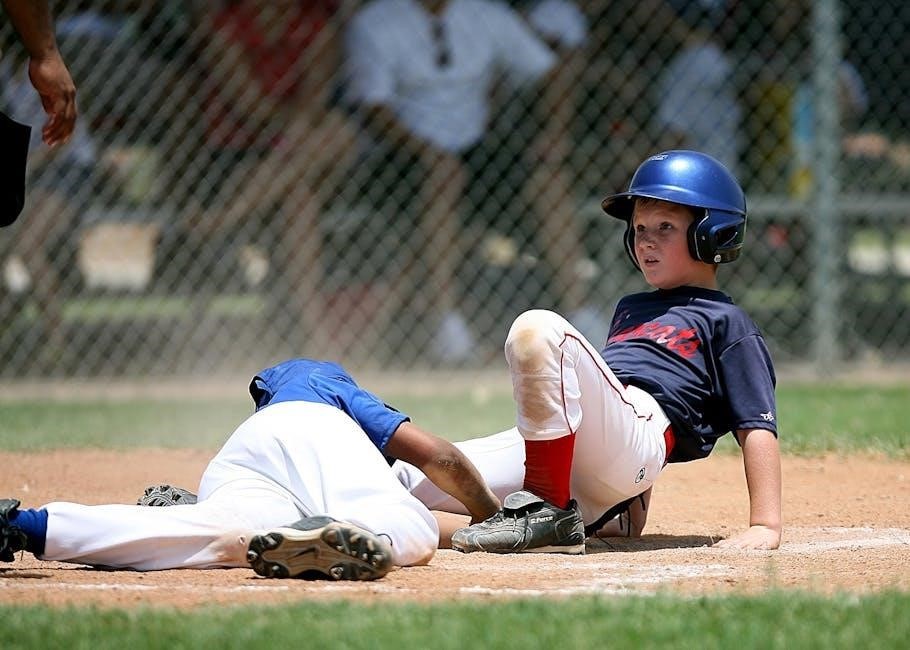
Official Rules and Regulations
NFHS rules govern baseball signals, distinguishing legal from illegal actions. Coaches must ensure compliance to avoid penalties, maintaining fair play and sportsmanship throughout the game.
NFHS Rules Governing Baseball Signals
The National Federation of State High School Associations (NFHS) establishes rules for baseball signals, ensuring fair play and sportsmanship. These rules define legal and illegal signals, with penalties for violations. Coaches must avoid deceptive practices, such as hidden signals or unauthorized communication. The third base coach’s signals must be clear and within the rules to prevent confusion or unfair advantages. NFHS guidelines emphasize the importance of ethical communication, balancing strategy with adherence to regulations. Understanding these rules is crucial for coaches to maintain integrity and avoid penalties during games. Compliance ensures a level playing field for all teams.
Understanding Legal and Illegal Signals
Legal signals in baseball are clear, visible, and follow NFHS guidelines, ensuring fair play. Illegal signals involve deception, such as hidden gestures or unauthorized communication. Coaches must avoid misleading tactics, as these can lead to penalties or ejections. The third base coach’s signals must be transparent to prevent confusion or unfair advantages. Understanding the distinction between legal and illegal signals is crucial for maintaining game integrity. Coaches and players must adhere to these rules to ensure sportsmanship and fair competition. Proper execution of signals within legal boundaries fosters a respectful and competitive environment, aligning with the spirit of the game.
Mastering third base coach signals enhances team strategy and execution. Effective communication is key to success. Download the comprehensive PDF guide to elevate your coaching skills today.
Mastering the Art of Third Base Coaching
Mastering the art of third base coaching requires a deep understanding of signals, situational awareness, and clear communication. Coaches must consistently relay strategies through hand gestures, verbal cues, and decoys to guide runners and batters effectively. The ability to read the game and make split-second decisions is crucial for maximizing scoring opportunities. A well-organized signals system ensures players execute plays without confusion. Coaches should adapt their strategies to the strengths and weaknesses of their team, while also considering the opponent’s tactics. By combining experience, intuition, and a comprehensive signals guide, coaches can elevate their team’s performance and achieve success on the field.
Final Thoughts on Effective Signal Usage
Effective signal usage is the cornerstone of successful third base coaching, ensuring clear communication and strategic execution. Coaches must prioritize simplicity and consistency to avoid confusion, especially with younger players. A well-organized signals system, combined with verbal cues and decoys, enhances teamwork and outsmarts opponents. Avoid overcomplicating signs, as clarity is key to quick decision-making. Coaches should continuously teach and reinforce signals, adapting them to the team’s strengths and game situations. By mastering these strategies, coaches empower players to perform confidently and effectively, ultimately elevating the team’s overall performance and achieving victory on the field.
Encouragement to Download the Comprehensive PDF Guide
Take your coaching to the next level with our comprehensive baseball third base coach signals PDF guide. Packed with detailed strategies, clear visuals, and expert tips, this guide simplifies complex signaling systems. Whether you’re a seasoned coach or just starting out, it offers invaluable insights into offensive and defensive plays, situational tactics, and avoiding common mistakes. Designed for quick reference, the guide ensures consistency and clarity, helping your team execute plays with precision. Download now and empower your players with the knowledge they need to succeed. Master the art of third base coaching and lead your team to victory with confidence!
